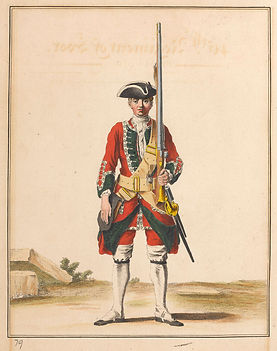

About The Author
About The Author
About The Author
About The Regiment
The Sherwood Foresters ranked 45th in the order of precedence of British infantry regiments. Their history dates back to 1741 when Colonel Houghton first raised a battalion of foot. Their early service was in North America, including the American Revolution in which they took heavy casualties. Returning to England with barely 100 men, the city of Nottingham offered to provide 300 volunteers in exchange for the regiment adopting Nottinghamshire in its title.
During the Napoleonic Wars the 45th Foot served in the Spanish Peninsula under Wellington, and were in the thick of many battles, most notably the bloody assault on Badajoz on 6 April 1808, a date still commemorated in the regimental calendar.
Under the reforms of the mid-nineteenth century single-battalion regiments were merged together and given distinctive county names. The 45th was merged with the 95th, which had associations with Derbyshire, and together they became the Nottinghamshire and Derbyshire Regiment. The 95th had only been formed in 1820 but they inherited many of the light infantry traditions of the famous 95th Rifles which had also fought in Spain under Wellington. The new regiment had performed bravely in the Crimea and in India, where it had won the first of 16 Victoria Crosses.
The merged regiment served in Egypt and India, and in 1899 the 1st Battalion was sent to South Africa to fight the Boers. This conflict was notable for the first large scale deployment of British volunteers overseas.
During the First World War about 140,000 men served in the regiment in 33 battalions, which served in most of the major battles on the Western Front, at Gallipoli and in Egypt, and in Italy, winning 57 battle honours. Its most memorable achievement was the breaking of the Hindenburg Line by the 139th Foresters Brigade in September 1918 as part of the 46th (East Midlands) Division. The regiment won over 2,000 gallantry awards but suffered 11,409 killed, and in 1923 a memorial was dedicated near the village of Crich to those who had served, which is visible from both counties.
During the Second World War there were 14 battalions, which served in Norway, France, Great Britain, Palestine, North Africa, Singapore, India and Italy.

Since the war the infantry regiments of the British Army have gradually been reduced in number. The regiment escaped amalgamation in the 1950s but merged with the Worcestershire Regiment to become the Worcester and Sherwood Foresters Regiment (WFR) in 1970. In 2007 after further amalgamation it became part of the Mercian Regiment, which is its designation today.
There are two regimental museums, one located in Nottingham Castle. and the other in the Derby Museum
The regimental archive is located in Nottingham. It can be contacted here on its website.



